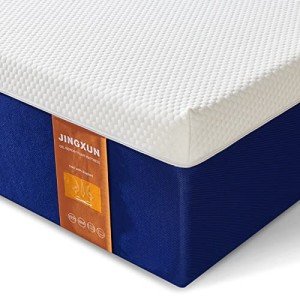Mattress With Memory Foam: What's No One Has Discussed
The Benefits and Considerations of Memory Foam Mattresses
Memory foam mattresses have revolutionized the sleep market, providing a distinct mix of convenience and assistance that adjusts to the shapes of the body. Understood for their extraordinary ability to relieve pressure points, enhance comfort, and minimize motion transfer, these mattresses have actually become a popular choice for many people. This short article looks into the different aspects of memory foam mattresses, including their advantages, considerations, and professional suggestions, helping consumers make notified getting choices.
What is Memory Foam?
Memory foam, initially established by NASA in the 1960s, is a viscoelastic material that adheres to the body shape of the sleeper. It is understood for its distinct properties: high density and slow recovery, enabling it to take in weight and disperse pressure equally while going back to its initial shape. Plush Memory Foam Mattress makes memory foam a perfect material for mattresses, offering support while reducing discomfort.
Advantages of Memory Foam Mattresses
Memory foam mattresses offer many benefits that contribute to better sleep quality:
Pressure Relief: Memory foam contours to the shape of the body, reducing pressure on sensitive locations such as hips, shoulders, and joints.
Spinal Alignment: Proper back alignment is essential for an excellent night's sleep. Memory foam mattresses supply balanced assistance, promoting a neutral spinal column position.
Motion Isolation: Memory foam absorbs and separates motion, making it an excellent choice for couples. Movement by one person usually does not disturb the other, permitting both people to delight in uninterrupted sleep.
Hypoallergenic Properties: Many memory foam mattresses are resistant to irritants, dust mites, and mold, making them an appropriate choice for allergic reaction patients.
Resilience: High-quality memory foam mattresses can last longer than traditional spring mattresses, maintaining their shape and support in time.
Factors to consider When Choosing a Memory Foam Mattress
While memory foam mattresses have many advantages, potential purchasers must also understand certain factors to consider:
Heat Retention: Memory foam can keep heat, making some sleepers feel too warm. Many modern-day mattresses incorporate cooling technologies, such as gel-infused foam or breathable covers, to mitigate this concern.
Preliminary Odor: New memory foam mattresses can produce a preliminary chemical odor, frequently called off-gassing. This scent typically dissipates within a few days in a well-ventilated area.
Weight: Memory foam mattresses can be heavy, making them difficult to move or set up without help.
Firmness Variation: Different brands and designs offer various firmness levels. It is vital to evaluate a mattress's feel before buying to guarantee it meets individual comfort preferences.
- * *
Function
Memory Foam
Standard Spring
Hybrid
Pressure Relief
Outstanding
Fair
Good
Motion Isolation
Outstanding
Poor
Good
Heat Retention
Moderate
Low
Low
Spinal Alignment
Exceptional
Fair
Good
Sturdiness
Excellent
Moderate
Excellent
- * *
Kinds Of Memory Foam Mattresses
When checking out memory foam mattresses, it is very important to understand the various types offered:
Traditional Memory Foam: The original viscoelastic foam uniquely conforms to the body but may retain heat.
Gel Memory Foam: Infused with gel particles, this foam supplies a cooler sleeping surface while preserving contouring properties.
Open-Cell Memory Foam: Designed with a structure that allows air to flow through, open-cell memory foam offers much better breathability and decreases heat retention.
Plant-Based Memory Foam: Made with particular natural plant oils, these foams objective for a smaller environmental impact and can have much better breathability than traditional foam.
Tips for Selecting a Memory Foam Mattress
When selecting a memory foam mattress, think about the following tips:
Test Before You Buy: Try out the mattress in-store if possible or ensure it comes with a sleep trial.
Consider Your Sleep Position: Side sleepers might choose a softer firmness to relieve pressure on their shoulders and hips, while back and stomach sleepers may gain from a firmer mattress to keep spine positioning.
Examine Warranty and Return Policy: A good warranty can protect your financial investment, and a versatile return policy offers comfort.
Research study Brands: Look for reliable brands with positive customer reviews and scores from independent sources.
Often Asked Questions (FAQs)
**1. For how long do memory foam mattresses last?Most high-quality memory foam mattresses have a life expectancy of 10 to 15 years with proper care. 2. Can memory foam mattresses be
flipped?Most memory foam mattresses are designed
to be single-sided and do not need turning. Nevertheless, turning Breathable Memory Foam Mattress can aid with wear. 3. Are memory foam mattresses heavy?Yes, memory foam mattresses tend
to be heavier than traditional spring mattresses due to their dense products. 4. Can memory foam mattresses get too hot?Some individuals find memory foam keeps heat. Search for gel-infused or
**open-cell foam alternatives for more breathability. 5. Are there financing options for acquiring a memory foam mattress?Many sellers use financing plans, permitting clients to break the total cost into workable payments. Memory foam mattresses have become a popular choice for those seeking
convenience and support in their sleep environment. With a myriad of options and functions available, customers can
successfully find the very best mattress to meet their needs. Comprehending the benefits, factors to consider, and different kinds of memory foam will equip buyers with the knowledge to make an informed choice. As the demand for quality sleep continues to rise, memory foam mattresses will certainly play a substantial role in improving sleep health and overall well-being.  ****
****